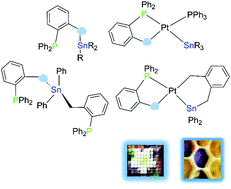Abstract
Semirigid bifunctional tin-substituted o-tolylphosphines of general formulae [Ph2P(o-C6H4CH2)SnR3] (R = Ph, 1; R = Me, 2) and [{Ph2P(o-C6H4CH2)}2SnPh2] (3) were synthesized and isolated in good yields. The new compounds were fully characterized by single-crystal X-ray diffraction and multinuclear solution NMR spectroscopic techniques. The observed J(119Sn,31P) values in solution NMR spectroscopy as well as the P⋯Sn distances in the solid state and DFT calculations (B3LYP) on compounds 1 and 3 do not support the existence of intramolecular P → Sn bond interactions in either of the three compounds. 1 and 2 reacted with stoichiometric amounts of tristriphenylphosphine platinum(0) [Pt(PPh3)3] under toluene refluxing conditions leading to formation of Pt(II) distorted square-planar complexes [Ph2P(o-C6H4CH2)Pt(SnR3)(PPh3)], (R = Ph, 4; R = Me, 5), each bearing a five-membered carbometallated ring resulting from Pt coordination to P and the benzylic C sp3 atom of the ligand architecture rather than from activation of the terminal Sn–C carbon bonds of the phenyl or methyl substituents which would have rendered six-membered rings. Additionally, the fragment SnR3 also binds to the metal centre disposing cis to the cyclometalated carbon atom and to the single remaining PPh3. This carbometallation takes place affecting the integrity of the ligand skeleton. NBO calculations show the Sn fragment coordinates to the metal as X-type stannyl, SnR3. The analogous reaction of [Pt(PPh3)3] towards the stannyldiphosphine 3 leads to the quantitative formation of complex [(Ph2P-o-C6H4CH2)Pt(Ph2P-o-C6H4CH2SnPh3)], 6, which exhibits five- and six-membered metallacycles at the expense of the ligand frame. All compounds were characterized exhaustively by solution spectroscopic measurements and by single crystal X-ray diffraction analysis. DFT computations corroborate the higher stability of the observed products over those resulting from preservation of the ligand backbone.

- This article is part of the themed collection: Breaking bonds over many timescales: in celebration of Robin Perutz’s 70th birthday


 Please wait while we load your content...
Please wait while we load your content...